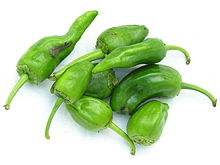| Padrón | |
|---|---|
 Unripe Padrón peppers Unripe Padrón peppers | |
| Species | Capsicum annuum |
| Origin | Galicia, Spain |
| Scoville scale | 500 to 2,500 SHU |
Padrón pepper, also called Herbón pepper, is a landrace variety of pepper (Capsicum annuum) from the municipality of Padrón in northwestern Spain.
Characteristics
Padrón peppers are small, about 2 inches (5 cm) long and have an elongated shape. They are often picked, sold and eaten unripe, when they are still green. The taste is mild, but some exemplars can be quite hot. This property has given rise to the popular Galician aphorism "Os pementos de Padrón, uns pican e outros non" ("Padrón peppers, some are hot, some are not"). Drought-stressed plants tend to produce hotter peppers. Like several other peppers, Padrón peppers become spicier as they mature. Their ripe colour is red.
Cultivation
The species Capsicum annuum is native to southern North America, the Caribbean, and northern South America where it was domesticated. The Padrón pepper variety originates from the municipality of Padrón in the province of A Coruña, Galicia, northwestern Spain. European Union law has protected the name "pemento de Herbón" as a protected designation of origin since 2010. Padrón peppers are now also grown elsewhere in the Mediterranean and in the United States.
Padrón peppers are picked when immature and green.
Culinary preparation

Padrón peppers are customarily fried in olive oil until the skin starts to blister and the pepper collapses.
In and around the town of Padrón, the stems are removed before frying. Removing the stems is recommended by major Galician pepper producers and the head of the Galician tourism association on the grounds that they cause bitterness in fried peppers. Elsewhere, the stems are generally left on the peppers, and the stems are used to hold the peppers while eating.
Fried Padrón peppers are typically served hot with a dusting of coarse salt, sometimes accompanied by chunks of bread, as tapas.
See also
- List of Capsicum cultivars
- Shishito, a very similarly used pepper in Japan
References
- Walton, Stuart (2018). The Devil's Dinner: A Gastronomic and Cultural History of Chili Peppers. St. Martin's Publishing Group. ISBN 978-1-250-16321-9.
- ^ Gourmetour: Food, Wine & Travel Quarterly Magazine. INFE. 2000. p. 89.
- Rivera, Antonio; Monteagudo, Ana B.; Igartua, Ernesto; Taboada, Alfredo; García-Ulloa, Alba; Pomar, Federico; Riveiro-Leira, Manuel; Silvar, Cristina (2016-05-12). "Assessing genetic and phenotypic diversity in pepper (Capsicum annuum L.) landraces from North-West Spain". Scientia Horticulturae. 203: 1–11. doi:10.1016/j.scienta.2016.03.006. hdl:10261/130170. ISSN 0304-4238.
- Davis, Kat (2018). The Camino Portugues: From Lisbon and Porto to Santiago - Central, Coastal and Spiritual caminos. Cicerone Press Limited. ISBN 978-1-78362-636-6.
- Baró, Gonzalo (2018). Vegan Recipes from Spain. Grub Street Cookery. p. 52. ISBN 978-1-911667-53-7.
- Estrada, B.; Pomar, F.; Dı́Az, J.; Merino, F.; Bernal, M.A (1999-10-11). "Pungency level in fruits of the Padrón pepper with different water supply". Scientia Horticulturae. 81 (4): 385–396. doi:10.1016/S0304-4238(99)00029-1. ISSN 0304-4238.
- Rombauer, Irma S.; Becker, Marion Rombauer; Becker, Ethan; Becker, John; Scott, Megan (2019). Joy of Cooking: 2019 Edition Fully Revised and Updated. Simon and Schuster. p. 260. ISBN 978-1-5011-6971-7.
- Estrada, B.; Pomar, F.; Diaz, J.; Merino, F.; Bernal, A. (1997). "Evolution of capsaicinoids in Capsicum annuum L. var. annuum cv. Padrón fruit at different growth stages after flowering". Capsicum Eggplant Newsletter. 16: 60–63.
- ^ Capsicum & Eggplant Newsletter. Plant Breeding and Seed Production, . 1998.
- "Padrón pepper". Germplasm Resources Information Network. Agricultural Research Service, United States Department of Agriculture.
- "D.O.P. Pemento de Herbón". www.mapa.gob.es (in Spanish). Retrieved 2021-07-22.
- Palma, José M.; Terán, Fátima; Contreras-Ruiz, Alba; Rodríguez-Ruiz, Marta; Corpas, Francisco J. (September 2020). "Antioxidant Profile of Pepper (Capsicum annuum L.) Fruits Containing Diverse Levels of Capsaicinoids". Antioxidants. 9 (9): 878. doi:10.3390/antiox9090878. hdl:10234/190199. PMC 7554748. PMID 32957493.
- Winston, Steve (2009). The Spanish Table: Traditional Recipes and Wine Pairings from Spain and Portugal. Gibbs Smith. p. 36. ISBN 978-1-4236-0818-9.
- Balla, Nicolaus; Burns, Cortney (2014). Bar Tartine: Techniques & Recipes. Chronicle Books. p. 230. ISBN 978-1-4521-3235-8.
- Rockridge Press (2014). Hot Sauce Cookbook: The Book of Fiery Salsa and Hot Sauce Recipes. Callisto Media. ISBN 978-1-62315-366-3.
- ^ "En Padrón no hay debate: los pimientos se fríen sin tallo". La Voz de Galicia (in Spanish). 2019-07-14. Retrieved 2021-07-22.
- ^ Torrado, C.B. (August 24, 2019). "Los pimientos, ¿con o sin rabo?". La Voz de Galicia.
- DK Publishing (15 February 2010). Back Roads Spain. DK Publishing. pp. 34–. ISBN 978-0-7566-7181-5.